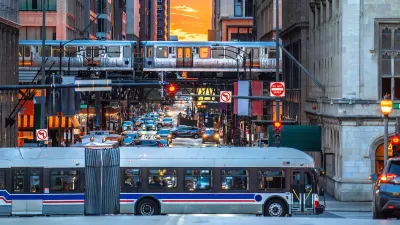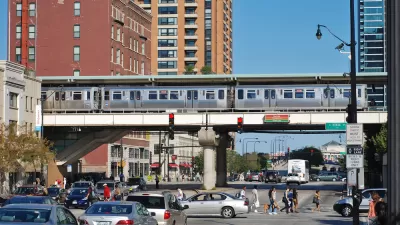An analysis of infill transit stations built since 2012 along "L" routes in Chicago shows clear increases in ridership and transit oriented development.
"Over the past few years, Chicago has invested in three new 'infill' stations located along existing ‘L’ tracks, filling service gaps between stops and expanding access to the transit system," according to an article by Yonah Freemark and Mengwei Sun that credits those infill station with some of the increased ridership on the system as well as new opportunities for transit oriented development.
The CTA opened two infill stations in 2012, according to the article, "one at Morgan Street on the Green and Pink Lines and one at Oakton Street on the Yellow Line." Another station "opened at Cermak Road on the Green Line near the McCormick Place convention center in the South Loop neighborhood."
As Freemark and Sun note, "Morgan Station has been particularly effective in bringing new development to the West Loop and now attracts more than 2,300 daily riders as of March 2015." TheCermak-McCormick Place station, though brand new, has had an immediate impact on ridership. The article digs deeper into the initial data available for analysis in the wake of the new station's opening, on ridership on the "L" line, its effect on nearby bus lines, and its effect on the local real estate market.
FULL STORY: How the Cermak-McCormick ‘L’ station could create a real estate boom in the South Loop

Manufactured Crisis: Losing the Nation’s Largest Source of Unsubsidized Affordable Housing
Manufactured housing communities have long been an affordable housing option for millions of people living in the U.S., but that affordability is disappearing rapidly. How did we get here?

Americans May Be Stuck — But Why?
Americans are moving a lot less than they once did, and that is a problem. While Yoni Applebaum, in his highly-publicized article Stuck, gets the reasons badly wrong, it's still important to ask: why are we moving so much less than before?

Using Old Oil and Gas Wells for Green Energy Storage
Penn State researchers have found that repurposing abandoned oil and gas wells for geothermal-assisted compressed-air energy storage can boost efficiency, reduce environmental risks, and support clean energy and job transitions.

Greening Oakland’s School Grounds
With help from community partners like the Trust for Public Land, Oakland Unified School District is turning barren, asphalt-covered schoolyards into vibrant, green spaces that support outdoor learning, play, and student well-being.

California Governor Suspends CEQA Reviews for Utilities in Fire Areas
Utility restoration efforts in areas affected by the January wildfires in Los Angeles will be exempt from environmental regulations to speed up the rebuilding of essential infrastructure.

Native American Communities Prepare to Lead on Environmental Stewardship
In the face of federal threats to public lands and conservation efforts, indigenous groups continue to model nature-centered conservation efforts.
Urban Design for Planners 1: Software Tools
This six-course series explores essential urban design concepts using open source software and equips planners with the tools they need to participate fully in the urban design process.
Planning for Universal Design
Learn the tools for implementing Universal Design in planning regulations.
Heyer Gruel & Associates PA
City of Moreno Valley
Institute for Housing and Urban Development Studies (IHS)
City of Grandview
Harvard GSD Executive Education
Salt Lake City
NYU Wagner Graduate School of Public Service
City of Cambridge, Maryland





























